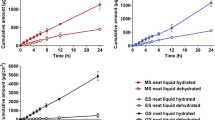Abstract
The relationship between the permeability of solutes undergoing transport via the lipid pathway of the stratum corneum and the degree to which the same solutes partition into the stratum corneum has been explored by measuring the permeability coefficients and stratum corneum/water partition coefficients of a series of hydrocortisone esters varying in lipophilicity. Isolated human stratum corneum, used in both the permeability and the uptake experiments, was shown to resemble full-thickness skin in its overall resistance and selectivity to solute structure. As with full-thickness skin, delipidization destroys the barrier properties of isolated stratum corneum. Although a linear relationship is frequently assumed to exist between permeability coefficients and membrane/water partition coefficients, a log–log plot of permeability coefficients versus the intrinsic stratum corneum/water partition coefficients for the series of hydrocortisone esters studied is distinctly nonlinear. This nonlinearity arises from the fact that the transport of these solutes is rate limited by a lipid pathway in the stratum corneum, while uptake reflects both lipid and protein domains. From the relative permeability coefficients of 21-esters of hydrocortisone varying in acyl-chain structure, group contributions to the free energy of transfer of solute into the rate-limiting barrier microenvironment of the stratum corneum lipid pathway are calculated for a variety of functional groups including the −CH2−, −CONH2, −CON(CH3)2, -COOCH3, −COOH, and −OH groups. These are compared to contributions to the free energies of transfer obtained for the same functional groups in octanol/water, heptane/water, and stratum corneum/water partitioning experiments. The group contributions to transport for polar, hydrogen-bonding functional groups are similar to the values obtained from octanol/water partition coefficients. This similarity suggests that complete loss of hydrogen bonding does not occur in the transition state for passive diffusion via the lipid pathway.
Similar content being viewed by others
REFERENCES
R. J. Scheuplein. J. Invest. Dermatol. 48:79–88 (1967).
R. J. Scheuplein and I. J. Blank. Physiol. Rev. 51:702–747 (1971).
S. K. Chandrashekaran and J. E. Shaw. Curr. Probl. Dermatol. 7:172–186 (1978).
G. L. Flynn, H. Durrheim, and W. I. Higuchi. J. Pharm. Sci. 70:52–56 (1981).
G. L. Flynn. In R. Bronaugh and H. Maibach (eds.), Mechanism of Percutaneous Absorption from Physicochemical Evidence, Marcel Dekker, New York, 1985, pp. 17–42.
R. J. Scheuplein, I. H. Blank, G. D. Brauner, and D. J. MacFarlane. J. Invest. Dermatol. 52:63–70 (1969).
A. J. Michaels, S. K. Chandrasekaran, and J. E. Shaw. AIChE J. 21:985–996 (1975).
P. M. Elias, E. R. Cooper, A. Korc, and B. E. Brown. J. Invest. Dermatol. 76:297–301 (1981).
W. P. Smith, M. S. Christenson, S. Nacht, and E. H. Gans. J. Invest. Dermatol. 78:7–11 (1982).
P. M. Elias. Arch. Dermatol. Res. 270:95–117 (1981).
P. M. Elias and D. S. Friend. J. Cell Biol. 65:180–191 (1975).
P. M. Elias, B. E. Brown, P. Fritsch, J. Goerke, G. M. Gray, and R. J. White. J. Invest. Dermatol. 73:339–348 (1979).
P. M. Elias, J. Goerke, and D. S. Friend. J. Invest. Dermatol. 69:535–546 (1977).
P. V. Raykar, M. Fung, and B. D. Anderson. Pharm. Res. 5:140–150 (1988).
A. M. Kligman and E. Christophers. Arch. Dermatol. 88:702–705 (1963).
L. Juhlin and W. B. Shelly. Acta Derm. Venereol. 57:289–96 (1977).
E. G. Bligh and W. J. Dyer. Can. J. Biochem. Physiol. 37:911–917 (1959).
R. Scheuplein and L. Ross. J. Soc. Cosmet. Chem. 21:853–873 (1970).
A. Leo, C. Hansch, and D. Elkins. Chem. Rev. 71:525–554 (1971).
H. Durrheim, G. L. Flynn, W. I. Higuchi, and C. R. Behl. J. Pharm. Sci. 69:781–786 (1980).
T. A. Hagen and G. L. Flynn. J. Membr. Sci. 30:47–65 (1987).
D. D. Perrin. Aust. J. Chem. 16:572–578 (1963).
C. Ackerman, G. L. Flynn, and W. M. Smith. Int. J. Pharm. 36:67–71 (1987).
M. M. Saket, K. C. James, and I. W. Kellaway. Int. J. Pharm. 27:287–298 (1985).
B. D. Anderson. In S. H. Yalkowsky, A. A. Sinkula, and S. C. Valvani (eds.), Physical Chemical Properties of Drugs, Marcel Dekker, New York, 1980, Chap. 7.
W. L. Hubbell and H. M. McConnell. J. Am. Chem. Soc. 93:314 (1971).
J. Seelig and A. Seelig. Q. Rev. Biophys. 13:19–61 (1980).
J. A. Marqusee and K. A. Dill. J. Chem. Phys. 85:434–444 (1986).
L. DeYoung and K. A. Dill (submitted for publication).
W. M. Smith. An Inquiry into the Mechanism of Percutaneous Absorption of Hydrocortisone and Its 21-n-Alkyl Esters, Ph.D. thesis, University of Michigan, Ann Arbor, 1982.
W. J. Lambert. Ph.D. thesis, University of Utah, Salt Lake City, 1988.
J. L. Fox, G. L. Flynn, T. Hagen, W. I. Higuchi, N. F. H. Ho, and H. Durrheim. Abstracts, APhA Academy of Pharmaceutical Sciences, Vol. 8(2), Nov. 1978, p. 100.
P. J. M. Stout, N. Khoury, J. Mauger, and S. Howard. J. Pharm. Sci. 75:65–67 (1986).
K. A. Johnson, G. B. Westermann-Clark, and D. O. Shah. J. Pharm. Sci. 76:277–285 (1987).
T. Yotsuyanagi and W. I. Higuchi. J. Pharm. Pharmacol. 24:934–941 (1972).
Y. Katz, M. E. Hoffman, and R. Blumenthal. J. Theor. Biol. 105:493–510 (1983).
J. M. Diamond and Y. Katz. J. Membr. Biol. 17:121–154 (1974).
W. R. Lieb and W. D. Stein. In W. D. Stein (ed.), Transport and Diffusion Across Cell Membranes, Academic Press, New York, 1986, Chap. 2.
S. S. Davis, T. Higuchi, and J. H. Rytting. In H. S. Bean, A. H. Beckett, and J. E. Carless (eds.), Advances in Pharmaceutical Sciences, Vol. 4, Academic Press, New York, 1974.
P. Raykar. Stratum Corneum Domain Effects on Solute Uptake and Transport, Ph.D. thesis, University of Utah, Salt Lake City, 1988.
B. D. Anderson and R. A. Conradi. J. Pharm. Sci. 69:424–430 (1980).
J. H. Rytting, L. P. Huston, and T. Higuchi. J. Pharm. Sci. 67:615–618 (1978).
J. Iwasa, T. Fujita, and C. Hansch. J. Med. Chem. 8:150 (1965).
Author information
Authors and Affiliations
Rights and permissions
About this article
Cite this article
Anderson, B.D., Higuchi, W.I. & Raykar, P.V. Heterogeneity Effects on Permeability–Partition Coefficient Relationships in Human Stratum Corneum. Pharm Res 5, 566–573 (1988). https://doi.org/10.1023/A:1015989929342
Issue Date:
DOI: https://doi.org/10.1023/A:1015989929342




